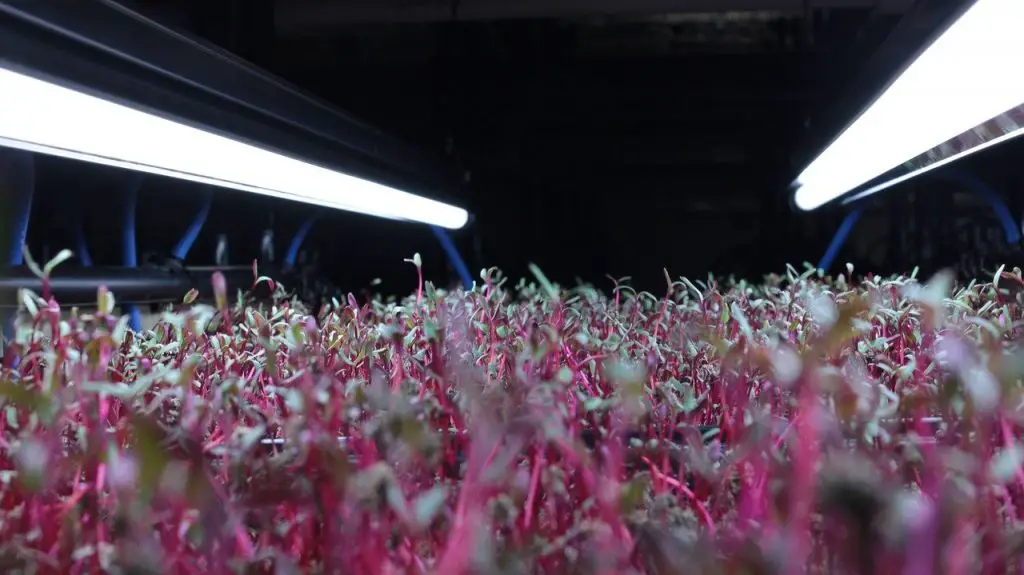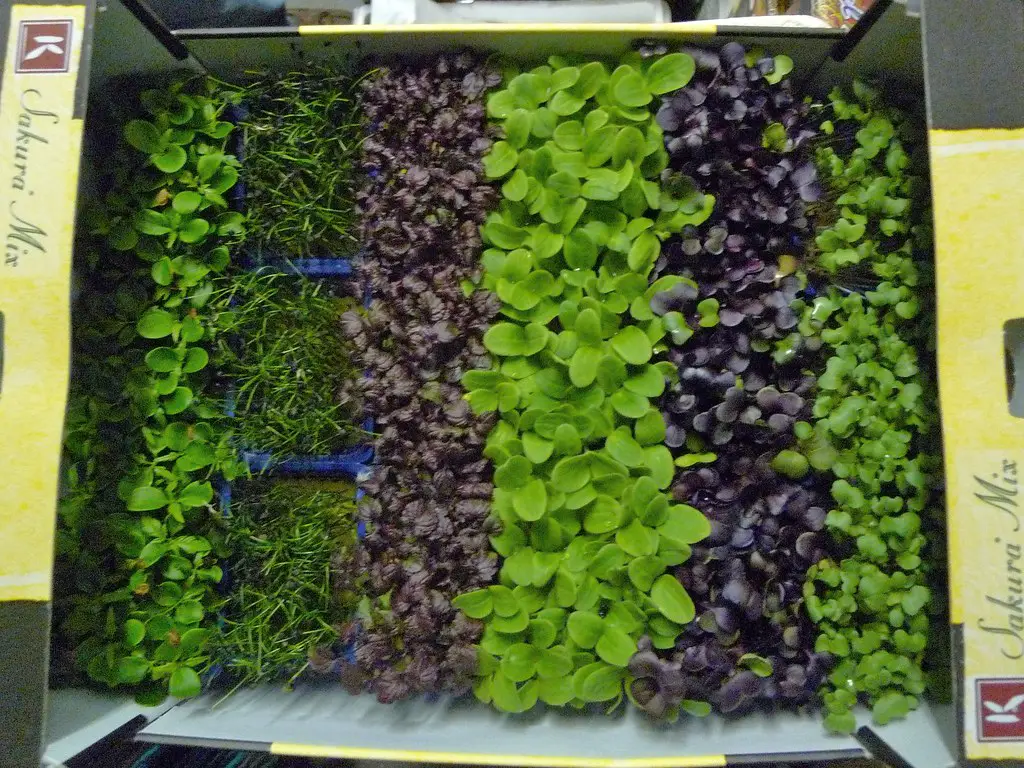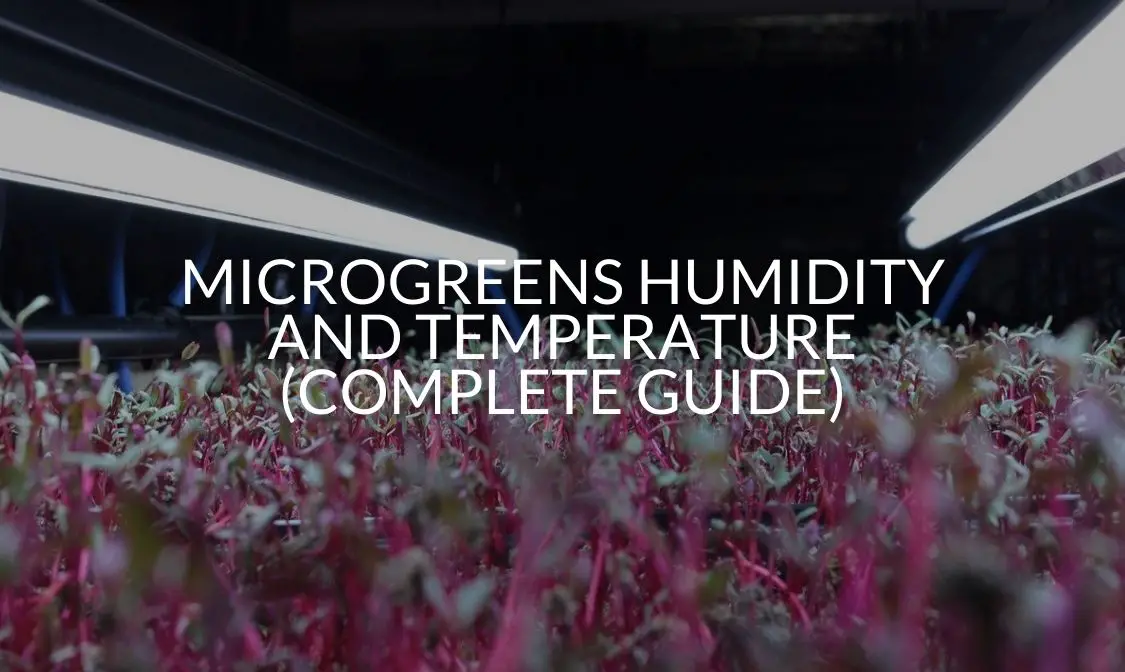All microgreens humdity and temperature require a certain amount of regulation and observance. It’s one of the most important factors to have a successful crop. Without the right temperature and humidity balance, microgreens will fail to grow to their fullest potential.
Understanding humidity, what it does and how it affects your microgreens will be your golden keys to gardening victory. There are things you can do to control humidity and emperature to ensure they turn out healthy, hardy and delicious.
What Is Humidity?
Moisture, or water vapor, in the atmosphere is humidity. How much humidity is in their air determines environmental comfort levels and whether clouds or rain have the potential to develop. This has a huge impact on plants and crop health. Humidity affects a plant’s tugor pressure, which indicates how much moisture is in the plant’s cells.
What’s The Ideal Humidity For Microgreens?
Most microgreens do well in 40% to 60% humidity. But this will very much depend on the plant’s stage of growth. For instance, the germination period should have a general humidity between 50% and 80%. Anything more or less could impact their growth, smell, appearance and taste, so controlling the humidity in the atmosphere is crucial.
What Happens When It’s Too Humid?
If the general climate is far too humid, several undesirable things can happen to microgreens. Sometimes, the plants will give off a horrid odor or turn yellow if the air’s moisture exceeds what the plant can handle.
Mold & Fungus
Fungus and mold are easy for microgreens to contract. This is almost always triggered by high levels of humidity in the air, the growing media or trapped humidity compounded with heat. This causes the disease to spread very fast and has the potential to ruin an entire crop.
(Find out more reasons mold is growing on your microgreens.)
Causes of Humidity
Humidity is a problem when growing plants and microgreens are no exception. Many things can cause a high amount of moisture in the air, especially indoors:
- Overwatering – your room is warm but there’s too much water in the soil
- Humidifier/Dehumidifier – an unnecessary level of moisture can affect the air if your humidifier is on high or your dehumidifier isn’t working
- Plants are too packed together – humidity can get trapped between the plants because you may have used too many seeds or didn’t spread them evenly enough when first planting them
- Allowing too much outside humidity to enter – if you have microgreens placed in a main thoroughfare of your house and it’s summertime, all your humidity control efforts may be for naught if there’s a constant barrage of humid air coming in
- Building-related issues – Things like leaks and gaps in walls and windows will allow excess moisture to enter the premises or area where you’re growing microgreens
- Daily activities – doing things like showering, cooking and exercising can all have an effect on your microgreens because you’re actually adding humidity to the surrounding environment
- Broken air conditioner – broken air conditioners are an unfortunate mishap that can cause your crop to fall, wilt and die
Proper Humidity
Microgreens do require humidity to a certain point. This is because they breathe carbon dioxide and absorb air moisture from their surrounding environment via the leaves. It’s a process that is imperative to their growth.
Post-Harvest Storage
Humidity also plays a crucial role after you’ve cut and harvested the microgreens. If you plan to dry them, ensuring there’s little to no moisture in their container will be important to prevent mold growth. Also, maintaining low humidity levels during the drying process will be important as well. Humidity during this stage can ruin your crop, even if you took great pains to grow them right.
What Happens If It’s Not Humid Enough?
Too low of humidity can also present its problems for your microgreens as well. Actually, low humidity can present more of a problem for microgreens than too much. Too little environmental moisture with affect the flavor.
Dehydration
If there’s rapid evaporation, the plant’s cells will weaken, forcing the microgreens to wilt because too little moisture in the air prevents proper development and growth. Depending on the type of plant, too little humidity will weaken their flavor or make them taste putrid.
Slow Germination
If your seeds are taking a long time to germinate, it could be that there’s not enough moisture in its environment to thrive. Make sure the soil is nice and moist, but not too wet. Also, be sure to start your seeds in a warm and moist surrounding so they germinate in the time they’re supposed to.
How To Measure Humidity
Chances are, if you think it’s too humid, your microgreens will feel that way too. But, if you’re unsure, you can measure the atmosphere’s humidity with a hygrometer. It’s a thermometer for water vapor in the immediate atmosphere. Knowing how much or little moisture is in the air will help you understand what measures to take so you can control the conditions.

How To Control Humidity
Once you know what’s going on with humidity issues, you can begin to solve them. Depending on your budget and what you have available to you, you might have to get resourceful. Some things will be easier to control and other aspects of humidity will be more difficult to handle. This will depend on several factors.
Decreasing Humidity
To prevent mold and fungal growth on your microgreens, you must remove as much humidity as possible. Always inspect the room where you keep the plants. Places like bathrooms and kitchens may not be ideal because they have higher humidity levels than the living room or bedroom.
Ventilation
Sometimes, all you need to control the air’s humidity level is turning on a small, oscillating fan. But, if you have a lot of microgreens, your ventilation system may not be adequate to circulate air in-and-out of the space. Stagnant air is a sure killer for proper microgreen growth.
Dehumidifiers
To extract water from the air fast, use a dehumidifier. This contraption removes excess moisture without affecting climactic temperature. But, if you have a larger area where you’re growing microgreens, then obtaining one may get quite expensive.
Air Conditioners
If you live in an area where the general climate has high humidity and/or it’s during the summer months, use an air conditioner to control humidity levels. This will be essential or your microgreens won’t survive.
Increasing Humidity
Too little humidity often occurs in cooler climates during the winter months. It’s also an issue if you’re trying to grow microgreens in higher altitudes or desert areas. But sometimes, it can be an issue with the structure of the building itself.
Humidifier
Humidifiers are a great way to ensure microgreens stay hydrated, especially if you can’t look after the plants as much as you’d like. Whether the humidifier also supplies heat will be a separate consideration. If temperature isn’t also an issue, make sure you get one that uses room temperature distilled water.
The only caveat with a humidifier is ensuring it stays clean and free of mold with regular filter changing. Also, they can get quite pricey the larger they get. You can find a small one for as little as $10 but they can be as much as $500 or more for larger sizes.
Misting
With a fine-mist spray bottle, squirt some water over your plants to ensure they receive proper humidity. The frequency in which you do this will depend on how dry the air is and how quickly the water vaporizes once it touches the foliage.
Related Articles
- Do Microgreens Regrow? (Or Should You Replant?)
- Why Are Your Microgreens Falling Over (And How To Fix It)
- Microgreens Lighting Guide (All FAQ’s Answered In-Depth!)
- Yellow Microgreens (Why It Happens & What To Do)

What’s The Ideal Temperature For Microgreens?
Next to humidity, temperature is of equal importance. Most microgreens do well in an average room temperature, about 70°F. But, of course, this is going to depend on its stage of growth, the current season and what type of plant you’re growing.
What Happens When It’s Too Hot?
Although microgreens often love a warm environment, there are a few issues that can pop up if the temperature is too hot.
Falling
Falling microgreens are often the result of temperatures being too hot. This often accompanies too much moisture.
Foul Taste or Smell
If you notice a horrid odor or the leaves taste bad, hot temperatures could be the culprit. This can permanently affect the flavor if not taken care of in a quick manner.
Germination
If the temperature is too hot when first starting your microgreens, they may end up weak and uneven. If the heat is coming from a light source, your seeds may be experiencing too much heat and they will struggle to come through.
What Happens When It’s Too Cold?
Microgreens must stay warm around a balmy temperature of 70°F. If the temperature drops, chances are, so does the humidity.
Germination
If the temperature isn’t right, microgreens won’t germinate right. They’ll wait until the conditions are appropriate, thereby making the entire crop uneven in growth. They may also grow a little bit, then stop and perish.
How To Control Temperature
Controlling the surrounding temperature is very important. Depending on what stage of growth it’s in, heat requirements will change. Germination stages often require more heat than when they’re maturing and definitely cooler temperatures when they’re ready for harvesting.
Summertime
The hot, humid temperatures and climate that almost always accompanies the warmer months of the year will create some problems you have to control.
Ventilation
The best way to control temperature during the warmer months of the year, especially if the general climate is humid, is by using an air conditioner or a fan. Larger operations should have an adequate HVAC system to ensure air circulates properly throughout the space.
Outside
Placing your microgreens outside during the summer is okay so long as they’re getting no more than three hours of light in the morning and sit in the shade for the rest of the day.
Wintertime
Unless you live in a warmer tropical climate, wintertime temperatures are going to be too low for microgreens to thrive and survive. Either purchasing a heat mat or placing them near your furnace along with a grow light should help to combat temperature issues during the colder months of the year.
Articles You Might Like
- Fenugreek Microgreens (FAQ, How To Grow, Pests & Benefits)
- How To Grow Pea Microgreens (FAQ’s, Benefits, Pests)
- How To Grow Chia Microgreens (FAQ, Benefits, Pests)
Recap
Being meticulous and diligent about humidity and temperature will help ensure a delicious and well-grown microgreens crop. Monitoring levels with a hygrometer is a sure-fire way to maintain proper moisture quality. Making sure temperatures don’t exceed or drop below 70°F ensures their happiness. Being proactive is the best way to stop problems.

